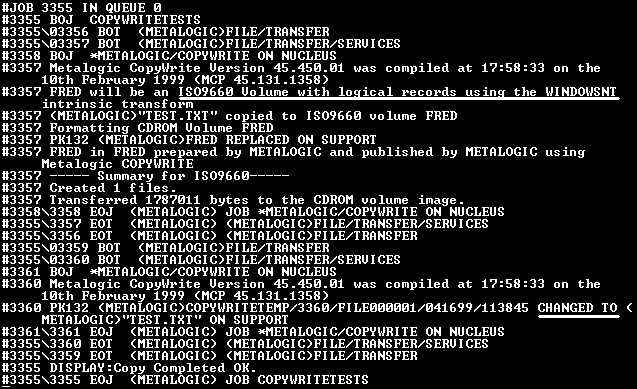| Example 21 - Copying a file from
an ISO9660 partition of a CD Image file on disk |
COPY
COPYWRITE/LIBRARY AS "TEST.TXT" TO
#MYTESTVOLUME(CD,HOSTNAME=LOCAL,
SCRATCHPOOL=WINDOWSNT)[T];
IF (T(TASKVALUE)=0) THEN
BEGIN
T(STATUS=NEVERUSED);
COPY "TEST.TXT" FROM
#MYTESTVOLUME(CD,LOCKEDFILE,HOSTNAME=LOCAL,SCRATCHPOOL=ISO9660)[T];
END; |
| |
 |
| |
- An ISO9660 CD image was created by copying a file
using the WINDOWSNT intrinsic transform.
- Since COPYWRITE can copy a file from any of the
file systems of a hybrid CD image, it must be
told which file system the file resides on.
- The file could lie on the ISO9660 or JOLIET
partition, or in the LIBRARY/MAINTENANCE
partition.
- TheLOCKEDFILE
attribute told COPYWRITE that the CD volume was
in an image file. The SCRATCHPOOL=ISO9660
told it that the file resides within the ISO9660
file system.
- ThePDT
utility function of COPYWRITE, or COPYWRITE
for NT, can be used to find out
what file systems exist on a CD or within a CD
image file.
- If a file on an ISO9660 or JOLIET partition has
no Extended Record Attribute (XAR), then it is
copied as a FRAME STREAM
file.
|
